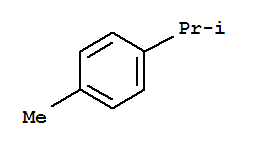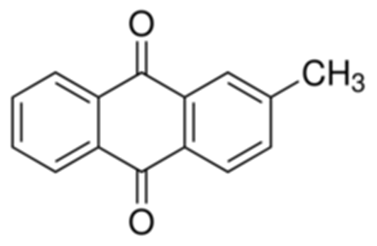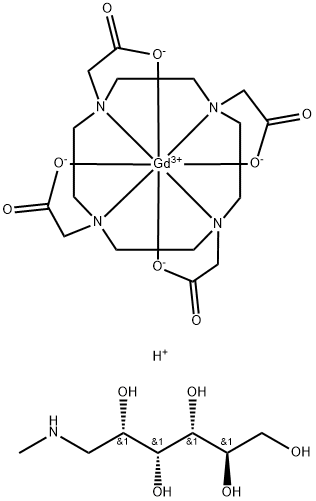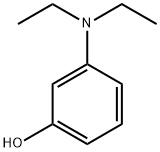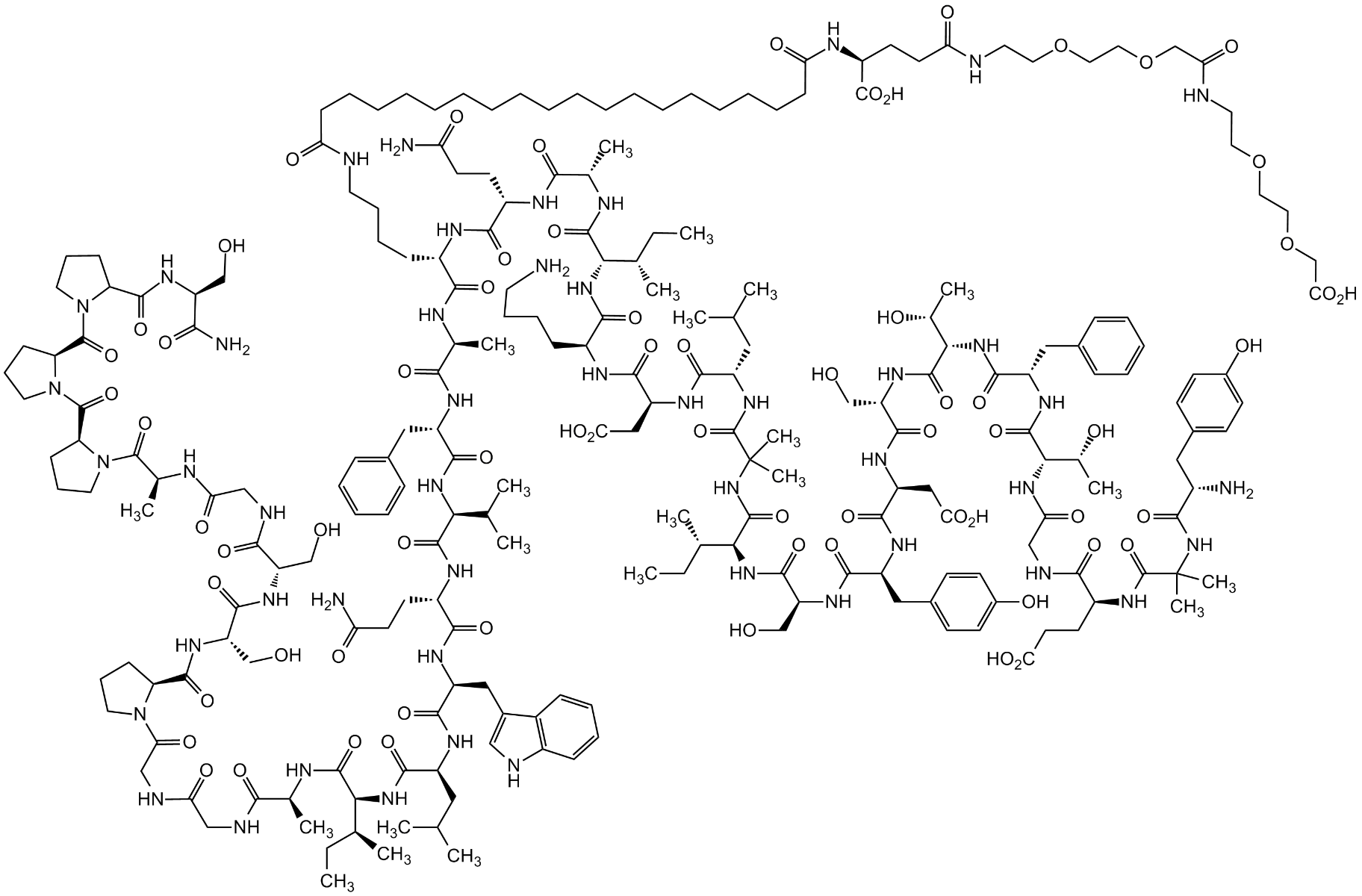p-Cymene literature
-
Barbier,Bouveault
, p. 1051 (1894)
-
Aerobic oxidative dehydrogenations catalyzed by the mixed-addenda heteropolyanion PV2Mo10O405-: A kinetic and mechanistic study
Neumann, Ronny,Levin, Michal
, p. 7278 - 7286 (1992)
The aerobic oxidative dehydrogenation of α-terpinene to p-cymene catalyzed by the mixed-addenda heteropolyanion PV2Mo10O405- has been used to investigate the oxidation mechanism catalyzed by this class of compounds. The kinetics of the reaction show it to be zero order in α-terpinene, first order in dioxygen, and second order in the heteropolyanion catalyst. The kinetic results along with the use of UV-vis, ESR, 31P NMR, and IR spectroscopy have enabled the formulation of a reaction scheme involving the formation of a stable substrate-catalyst complex in the catalyst reduction (substrate oxidation) stage and a μ-peroxo catalyst intermediate in the catalyst reoxidation where dioxygen is reduced to water in a four-electron redox reaction.
Unexpected Superoxide Dismutase Antioxidant Activity of Ferric Chloride in Acetonitrile
Foti, Mario C.,Ingold
, p. 9162 - 9165 (2003)
The azobis(isobutyronitrile)-initiated autoxidation of γ-terpinene in acetonitrile at 50 °C yields onlyp-cymene and hydrogen peroxide (1:1) in a chain reaction carried by the hydroperoxyl radical, HOO. (Foti, M. C.; Ingold, K. U. J. Agric. Food Chem. 2003, 51, 2758-2765). This reaction is retarded by very low (μM) concentrations of FeCl3 and CuCl 2. The kinetics of the FeCl3-inhibited autoxidation are consistent with chain-termination via the following: Fe3+ + HOO . ? [FeIV-OOH]3+ and [Fe IV-OOH]3+ + HOO. → Fe3+ + H2O2 + O2. Thus, FeCl3 in acetonitrile can be regarded as a very effective (and very simple) superoxide dismutase. The kinetics of the CuCl2-inhibited autoxidation indicate that chain transfer occurs and becomes more and more important as the reaction proceeds, i.e., the inhibition is replaced by autocatalysis. These kinetics are consistent with-reduction of Cu2+ to Cu+ by HOO . and then the reoxidation of Cu+ to Cu2+ by both HOO. and the H2O2 product. The latter reaction yields HO. radicals which continue the chain.
-
Ipatieff,Pines,Olberg
, p. 694,695 (1945)
-
The effect of UTL layer connectivity in isoreticular zeolites on the catalytic performance in toluene alkylation
?ilková, Nadě?da,Eliá?ová, Pavla,Al-Khattaf, Sulaiman,Morris, Russell E.,Mazur, Michal,?ejka, Ji?í
, p. 55 - 60 (2016)
Toluene alkylation with isopropyl alcohol was used as a model reaction to investigate the effect of UTL-type layer connectivity in a series of isoreticular zeolites and related zeolitic materials. All prepared catalysts possess the same structure of the layers but their connectivity differs from amorphous pillars (IPC-1PI), double-four-rings (UTL), single-four-rings (IPC-2?=?OKO, International Zeolite Association code), oxygen bridges (IPC-4?=?PCR), or their combinations (IPC-6 and IPC-7). X-ray powder diffraction, scanning electron microscopy, and nitrogen adsorption isotherms were employed to characterize structural and textural properties of the studied catalysts. Deuterated acetonitrile was adsorbed on catalysts to determine the concentrations and type of individual acid sites. Toluene alkylation with isopropyl alcohol evidenced that toluene conversion increases with increasing size of zeolite channels. Simultaneously, selectivity in cymenes increased as open structure of these catalysts did not present optimum reaction volume for the bimolecular reaction of cymenes with toluene to n-propylbenzenes.
-
Ipatieff,Pines
, p. 1226 (1945)
-
-
Dodge
, p. 561 (1890)
-
Photooxidation of a conjugated diene by an exciplex mechanism: Amplification via radical chain reactions in the perylene diimide-photosensitized oxidation of α-terpinene
Chen, Liaohai,Lucia, Lucian A.,Gaillard,Whitten, David G.,Icil,Icli
, p. 9095 - 9098 (1998)
Irradiation of the perylene diimide (1) or 9,10-dicyanoanthracene (DCA) in the presence of α-terpinene (2-HH) in the presence of molecular oxygen leads to moderately efficient oxidation of 2-HH to p-cymene (2). Although 1 might be expected to photosensitize oxidations by the conventional "singlet oxygen pathways, spectroscopic studies indicate that while oxygen can quench the fluorescent singlet of 1, no singlet oxygen is produced. 2-HH is also an efficient quencher of the fluorescent singlets of 1 and DCA and, for nonpolar solvents such as methylene chloride, in each case the quenching results in formation of an exciplex or contact radical ion pair. Under conditions where quenching by 2-HH to form the exciplex is complete, maximum quantum yields of 2 are obtained, thus indicating that the exciplex is the precursor to its formation. Nonproductive decay of the exciplex to starting materials is its major fate, thus the moderately high quantum efficiencies for formation of 2 require a mechanism involving amplification. Spin-trapping experiments suggest the role of hydroperoxy radicals and amplification by a radical chain mechanism involving these radicals and the intermediate 2-H. is proposed. Possible paths for reaching these radicals from the exciplex are considered; either oxygen quenching of the exciplex or proton transfer within the exciplex followed by oxygen interception of the semireduced perylene diimide appear viable. For the reaction of DCA with 2-HH and oxygen, it is found that the much longer-lived exciplex undergoes quenching by oxygen.
New insight into solvent effects on the formal HOO. + HOO . reaction
Foti, Mario C.,Sortino, Salvatore,Ingold
, p. 1942 - 1948 (2005)
The 2,2′-azobis(isobutyronitrile)(AIBN)-induced autoxidation of γ-terpinene (TH) at 50°C produces p-cymene and hydrogen peroxide in a radical-chain reaction having HOO. as one of the chain-carrying radicals. The kinetics of this reaction in cyclohexane and teri-butyl alcohol show that chain termination involves the formal HOO. + HOO . self-reaction over a wide range of γ-terpinene, AIBN, and O2 concentrations. However, in acetonitrile this termination process is accompanied by termination via the cross-reaction of the terpinenyl radical, T., with the HOO. radical under conditions of relatively high [TH] (140-1000 mM) and low [O2] (2.0-5.5 mM). This is because the formal HOO. + HOO. reaction is comparatively slow in acetonitrile (2k~8×107 M-1 s-1), whereas, this reaction is almost diffu-sion-controlled in tert-butyl alcohol and cyclohexane, 2k~6.5×108 and 1.3×109 M-1 s-1 respectively. Three mechanisms for the bimolecular self-reaction of HOO. radicals are considered: 1) a head-to-tail hydrogen-atom transfer from one radical to the other, 2) a head-to-head reaction to form an intermediate tetroxide, and 3) an electrontransfer between HOO . and its conjugate base, the superoxide radical anion, O 2-.. The rate constant for reaction by mechanism (1) is shown to be dependent on the hydrogen bond (HB) accepting ability of the solvent; that by mechanism (2) is shown to be too slow for this process to be of any importance; and that by mechanism (3) is de-pendent on the pH of the solvent and its ability to support ionization. Mechanism (3) was found to be the main termination process in tert-butyl alcohol and acetonitrile. In the gas phase, the rate constant for the HOO. + HOO. reaction (mechanism (1)) is about 1.8× 109 M-1 s-1 but in water at pH ≤2 where the ionization of HOO. is completely suppressed, this rate constant is only 8.6×105 M-1 s-1. The very large retarding effect of water on this reaction has not previously been explained. We find that it can be quantitatively accounted for by using Abraham's HB acceptor parameter, β2H, for water of 0.38 and an estimated HB donor parameter, α2 H, for HOO. of about 0.87. These Abraham parameters allow us to predict a rate constant for the HOO. + HOO. reaction in water at 25°C of 1.2×106 M-1 s-1 in excellent agreement with experiment.
Mechanism of inhibition of lipid peroxidation by γ-terpinene, an unusual and potentially useful hydrocarbon antioxidant
Foti, Mario C.,Ingold
, p. 2758 - 2765 (2003)
γ-Terpinene (TH), a monoterpene hydrocarbon present in essential oils, retards the peroxidation of linoleic acid (LH). The peroxidation of TH has been shown to yield p-cymene as the only organic product in a chain reaction in which the chain carrier is the hydroperoxyl radical, HOO.. The peroxidation of LH is well-known to be a chain reaction in which the chains are carried by linoleylperoxyl radicals, LOO., and the products are linoleyl hydroperoxides. The retardation of LH peroxidation by TH has been found to be due to rapid chain termination via a very fast cross-reaction between HOO. and LOO. radicals. This antioxidant mechanism is completely different from the mechanism of antioxidant action of vitamin E. Since vitamin E becomes a prooxidant at high concentrations, the addition of essential oils containing TH to edible lipids may provide an alternative or supplementary strategy for obtaining large increases in their oxidative stability and shelf life, something that cannot be achieved by simply adding more and more vitamin E.
The conversion of 1,8-cineole sourced from renewable Eucalyptus oil to p-cymene over a palladium doped γ-Al2O3 catalyst
Leita, Benjamin A.,Gray, Peter,O'Shea, Mike,Burke, Nick,Chiang, Ken,Trimm, David
, p. 98 - 102 (2011)
The conversion of 1,8-cineole, sourced from the steam distillation of Eucalyptus waste, to p-cymene has been studied. Both alumina and palladium on alumina have been found to be active catalysts, the latter producing p-cymene in near quantitative conversion. Catalyst testing coupled with catalyst characterisation showed the catalysts to be multifunctional, promoting dehydration, dehydrogenation and isomerisation in a one step process.
Absolute rate constants and transient intermediates in the free-radical-induced peroxidation of γ-terpinene, an unusual hydrocarbon antioxidant
Sortino, Salvatore,Petralia, Salvatore,Foti, Mario C.
, p. 1563 - 1567 (2003)
The peroxidation of γ-terpinene (TH) initiated by tert-butoxyl radicals has been investigated by means of nanosecond laser flash photolysis techniques in acetonitrile at room temperature. The absolute rate constants for the reactions implicated in the peroxidation process have been determined and the main short-lived intermediates, terpenyl and terpenylperoxyl radicals, have been detected. The rate constant for H-atom abstraction from TH by tert-butoxyl radicals, K3, has been found to be 1.4 × 108 M -1 s-1 while the values for the self-quenching of T? radicals, 2k4, and the addition of O2 to T? k 9, are, respectively, 1.2 × 1010 M-1 s-1 and 1.3 × 109 M-1 s-1. The overall results strongly substantiate the peroxidation mechanism recently proposed by Foti and Ingold, J. Agric. Food Chem., 2003, 51, 2758, and provide a solid basis for a better understanding of the unusual antioxidant activity exhibited by this hydrocarbon.
Deactivation of a ruthenium(II) N-heterocyclic carbene p-cymene complex during transfer hydrogenation catalysis
Miecznikowski, John R.,Bernier, Nicholas A.,Van Akin, Christopher A.,Bonitatibus, Sheila C.,Morgan, Maura E.,Kharbouch, Rami M.,Mercado, Brandon Q.,Lynn, Matthew A.
, p. 21 - 29 (2018)
A ruthenium (II) N-heterocyclic carbene (NHC) complex was synthesized to investigate ligand dissociation as a possible deactivation pathway for the catalytic cycle of a transfer hydrogenation reaction. Diiodo(1,3-dimethylbenzimidazole-2-ylidene)(p-cymene)ruthenium(II) was synthesized for use as the catalytic species and characterized using physico-chemical, spectroscopic methods, and single crystal X-ray diffraction. The transfer of hydrogen from isopropanol to acetophenone was followed using 1H NMR. We observed 94% conversion of the substrate to the alcohol product after 1?h. We also found that the p-cymene complex decomposed during the catalytic reaction to the extent of 80% deactivation after 1?h, based on 1H NMR spectrometry. From Gaussian calculations, an ultraviolet–visible spectrum that is in excellent agreement with the actual spectrum was computed, giving insight into the nature of the absorptions observed experimentally.
Solvent-free dehydrogenation of γ-terpinene in a ball mill: Investigation of reaction parameters
Szuppa, Tony,Stolle, Achim,Ondruschka, Bernd,Hopfe, Wieland
, p. 1288 - 1294 (2010)
The present article reports on the solvent-free dehydrogenation of γ-terpinene (1) in a planetary ball mill affording p-cymene (2) as the predominant reaction product. The influence of various reaction parameters and technical variables on the transformation of 1 has been assessed. Thus, it is shown that KMnO4 can be substituted by other, less-toxic and environmentally-benign oxidation agents (Oxone, NaIO4, I 2). In most cases the reaction yielded 2 with high selectivities, whereby conversion can be fine-tuned by variation of the oxidant-to-substrate ratio, the rotation frequency νrot, the number of milling balls nball or the type of grinding auxiliary employed. Contrary to particle refinement processes, the size of the milling balls d (constant mass) has no influence on the conversion and chemical yield. The Royal Society of Chemistry 2010.
Alkylation of Toluene with Isopropanol on Lantanum Modified ZSM-5 Zeolite
Abdullaeva,Voskressenskii,Akhmedova,Mamedov
, p. 190 - 197 (2020/12/17)
Abstract: The effect of lanthanum concentration on the physicochemical and catalyticproperties of HZSM-5 zeolite in a reaction of toluene alkylation withisopropanol was studied in a temperature range of 250–350°C. Based on the dataobtained by X-ray diffraction analysis, low-temperature nitrogen adsorption (BETmethod), and IR spectroscopy, it was shown that an increase in lanthanumconcentration in HZSM-5 from 1.0 wt % to 7.0 wt % reduces both the specificsurface area and the pore volume of the zeolite despite the retention of itscrystalline structure. This also results in redistribution of acid sites,specifically decreases the concentration of strong Br?nsted acid sites (B) andincreases that of moderate Lewis acid sites (L), thus decreasing the B/L ratiofrom 3.53 to 0.20. All these occurrences have a crucial effect on theselectivity of reaction products and, in particular, on the p-isopropyl toluene (4-IPT) selectivity. Maximumselectivity, making up 72.4%, is achieved by a zeolite containing 5.0 wt %lanthanum at a B/L ratio of 0.25.
Radical induced disproportionation of alcohols assisted by iodide under acidic conditions
Huang, Yang,Jiang, Haiwei,Li, Teng,Peng, Yang,Rong, Nianxin,Shi, Hexian,Yang, Weiran
supporting information, p. 8108 - 8115 (2021/10/29)
The disproportionation of alcohols without an additional reductant and oxidant to simultaneously form alkanes and aldehydes/ketones represents an atom-economical transformation. However, only limited methodologies have been reported, and they suffer from a narrow substrate scope or harsh reaction conditions. Herein, we report that alcohol disproportionation can proceed with high efficiency catalyzed by iodide under acidic conditions. This method exhibits high functional group tolerance including aryl alcohol derivatives with both electron-withdrawing and electron-donating groups, furan ring alcohol derivatives, allyl alcohol derivatives, and dihydric alcohols. Under the optimized reaction conditions, a 49% yield of 5-methyl furfural and a 49% yield of 2,5-diformylfuran were obtained simultaneously from 5-hydroxymethylfurfural. An initial mechanistic study suggested that the hydrogen transfer during this redox disproportionation occurred through the inter-transformation of HI and I2. Radical intermediates were involved during this reaction.
Halogen-Bridged Methylnaphthyl Palladium Dimers as Versatile Catalyst Precursors in Coupling Reactions
Doppiu, Angelino,Goo?en, Lukas J.,Hu, Zhiyong,Pirkl, Nico,Sivendran, Nardana
supporting information, p. 25151 - 25160 (2021/10/19)
Halogen-bridged methylnaphthyl (MeNAP) palladium dimers are presented as multipurpose Pd-precursors, ideally suited for catalytic method development and preparative organic synthesis. By simply mixing with phosphine or carbene ligands, they are in situ converted into well-defined monoligated complexes. Their catalytic performance was benchmarked against state-of-the-art systems in challenging Buchwald–Hartwig, Heck, Suzuki and Negishi couplings, and ketone arylations. Their use enabled record-setting activities, beyond those achievable by optimization of the ligand alone. The MeNAP catalysts permit syntheses of tetra-ortho-substituted arenes and bulky anilines in near-quantitative yields at room temperature, allow mono-arylations of small ketones, and enable so far elusive cross-couplings of secondary alkyl boronic acids with aryl chlorides.
Mesoporous tin phosphate as an effective catalyst for fast cyclodehydration of bio-based citral into p-cymene
He, Jian,Li, Hu,Wu, Hongguo,Yang, Song,Yu, Zhaozhuo
, (2021/09/28)
Effective synthesis of aromatic compounds from renewable biomass is highly important yet challenging. p-Cymene is an attractive aromatic compound with various promising applications in the manufacture of fine chemicals. In this study, a novel and effective catalytic system based on mesoporous tin phosphate (M-SnPO) with Lewis-Br?nsted dual acidity was developed for the fast synthesis of p-cymene from the cyclodehydration of bio-based citral. Up to 78.5% yield of p-cymene was achieved from the cyclodehydration of citral at 180 °C within only 0.5 h, superior to the results reported for benchmark homogeneous acid catalysts. Characterization of as-prepared M-SnPO catalyst via various techniques indicates that the synergic effect of Lewis and Br?nsted acidic sites, large pore-sized structure, and high surface area are responsible for its remarkable catalytic performance. In addition, the effectiveness of the M-SnPO catalyst could be almost sustained over multiple cycles without significant loss. The work herein is the first example of developing a Lewis-Br?nsted dual acidic heterogeneous catalyst for the fast synthesis of p-cymene from the cyclodehydration of citral.

